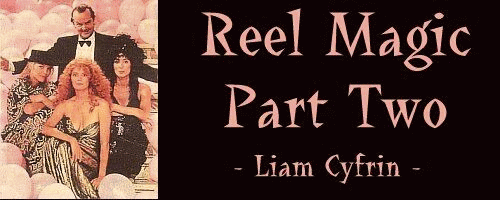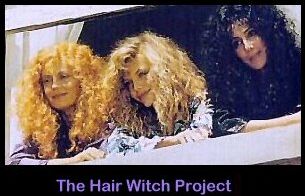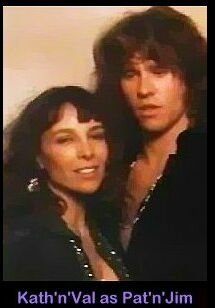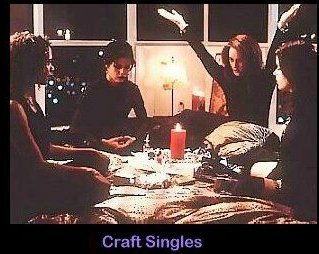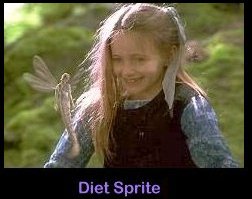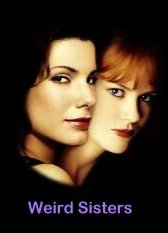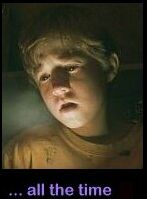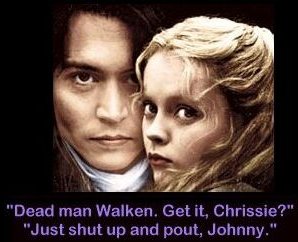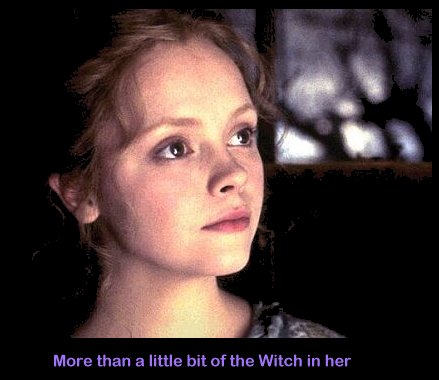 |
|||||||||||||||
|
|
|||||||||||||||
|
Warning: Witches ‘dancing with the Devil in the pale moonlight’ alert! Doesn’t happen in real life, no connection between the Craft and Satanism, yada yada and, for that matter, yada. Y’all know the drill. However, although the Prince of Darkness would occasionally return to bedevil screen Witches, The Witches of Eastwick marks the beginning of the end of the imagined partnership of the Craft and Old Nick. The latter is called up in this film in the form of one Daryl Van Horne, only to be well and truly trounced by the disenchanted enchantresses when they realise that he’s nothing more than the ultimate male chauvinist git. Satan, essentially, epitomises everything powerful women don’t need in a male and he gets himself pretty effectively exorcised from the whole Witch myth by the end of the film. A job like that requires a hefty dose of female energy. Luckily there’s more than enough here to go around. In fact, to date, no screen Coven has dethroned the combination of Susan Sarandon, Michelle Pfeiffer and Cher. Even their demonic co-star, Jack Nicholson, looks slightly dizzy when in shot with the three of them at once. Sadly, though, while the cast is one of the snazziest (and almost certainly the most expensive) in Witchy cinematic history to date, the film has problems. One catch is that Jack has such a grand old time chewing up the scenery in a tailor-made role that very few viewers have any interest in seeing him booted off screen, no matter how badly his character is treating people.
The film tries to regain its balance with some slapstick special effects later but our sympathy for the Witches never fully recovers. Movie making, like most other forms of magic, is always a matter of maintaining equilibrium, and unfortunately The Witches of Eastwick suffers badly from this serious tumble. Still and all, with a cast like this one in top form, Witches managed to wriggle its way on to our list with an effortlessness that Mr Van Horne would be proud of.
Oliver Stone’s Jim Morrison biography isn’t a film primarily about Witchcraft (though, in keeping with Morrison’s preoccupations, it could be considered a film about shamanism gone haywire). However, in the character of Patricia Kennealy, Wiccan Priestess and Jimbo’s handfasted wife, we get the nearest thing so far to an authentic portrayal of a more or less modern Witch. While the real Ms Kennealy, who appears in a cameo as the officiating Priestess at the handfasting, was less than enraptured with aspects of the film, Kathleen Quinlan portrays her as one of the strongest willed characters in the film and one of the few people to be able to slice her way through Jim’s considerable emotional defenses to get at the real person.
On the down side, the ‘uninitiated’ might end up imagining that blood imbibing and coke snuffling are integral parts of Witchy life, not twigging that the former was shown as part of a particular spell against impotence and the latter is a reflection of sixties lifestyles, not Wiccan. Genuine magical content aside, The Doors is an absolute spellbinder of a film. While one or two characterizations are dodgy (the mean-spirited take on Andy Warhol is well-nigh defamatory), Val Kilmer’s portrayal of Morrison borders on the supernatural itself at times. On top of which, the music still sounds pretty damned banging thirty years on.
Though there was a film called Teen Witch back in 1989 and the Sabrina character originated into Archie comics of the sixties, it’s fair to say that the current Teen Witch phenomenon starts here. Though not warmly received by the Wiccan community on its release, The Craft does earn its keep: three of the lead actresses put in above average teen-flick performances while the fourth is gobsmackingly fine; some of the early ritual and magical exercise sequences are, if not altogether accurate, at least true to the spirit of the real Craft; many of the spells are well worded; and the mix-and-match approach to magic (part genuine Wicca, part some peculiar ceremonial magic hybrid) is increasingly common among the characters’ real life equivalents, as are the mixed results caused by badly digested reading. Both the score and soundtrack albums are worth getting hold of too.
Fairuza, incidentally, made her first screen appearance at eleven as Dorothy in Disney produced sequel to The Wizard of Oz and shortly thereafter played Mildred Hubble, a (pre-Harry Potter) student at a Magic School in The Worst Witch (1986). The Worst Witch, as it turned out, was to get a whole lot worse. Oh, and while we're at it: free plug time. Klicken Sie hier.
Once again, no Crafty content this time, but plenty of little flittery Victorian fairies. Fairy Tale is based on the famous case of the Cottingley fairy photographs, pictures taken by two little girls that were alleged to be of actual little gnomey, spritey type people. They weren’t, of course, but what seems extraordinary in retrospect is how many people (including the photographs’ champion, Sir Arthur Conan Doyle) were prepared to believe in the images’ authenticity. With extreme gentleness, Fairy Tale places the phenomenon in a context where it becomes all to easy to understand. The photographs were first published in 1920 when Britain was still reeling from the carnage of First World War. The early part of the film (set in 1917) is full of images of injured and dazed soldiers returning from the trenches, some of whom will later be among the believers in the Cottingley fairies. The film makes it clear why: after experiencing some of the worst horrors imaginable, they had a desperate need to restore their belief in beauty and the magical if they were to continue making the effort of living. Conan Doyle himself (played by Peter O’Toole) is mourning the death of his own son when he first encounters the pictures. His friend, the stage magician, Harry Houdini (played by Harvey Keitel), knows perfectly well that the images are fakes but has the sensitivity and lack of arrogance to withstand any need to debunk them. He’s entirely aware of the purpose they serve.
While admitting that the photographs themselves were the products of the girls’ inventiveness, the film generously gives the fairies form, suggesting that, despite their methods, their vision was accurate all along. Well, who am I to say it wasn’t? Unfortunately, I wasn’t there at the time. The two little girls put in beautiful performances, by the way, magic always seeming to bring out the best in child actors.
Though it’s a perfectly good little film for a night in front of the video, no one could really argue that Practical Magic is one of the most innovative and satisfying of Witchflicks. It makes this list, however, because no other production gives a more complete picture of the entertainment industry’s current formulation of the Witch. Practical Magic blends aspects of earlier treatments of the Craft with most of the elements of the TV Witches that followed.
Along with this nostalgia, we also get most of the trademarks of the Charmed and Buffy tele-Witches. Beyond the issue of family ties, Charmed’s permanently perky Halliwell Witches have much more in common with Nicole Kidman and Sandra Bullock’s Owen sisters than they do with either the mature but frustrated Eastwick ladies or the angst-addicted school girls of The Craft. The resemblances continue. Sweet-natured sisterly loyalty (with occasional flare-ups of temper) co-exists cheerfully with casual, extreme and consequence-free violence. Men remain excluded from the Craft and only appear to be available in three varieties: the skeptical but helpful investigator; the love interest (these two often being combined, as is the case here); and, of course, the demon. And, naturally, all Witches could give up their day jobs and become supermodels at the drop of a pointy hat. A nice enough little movie in its own right, for good or ill, Practical Magic remains pretty much the state of the media Witch’s art.
On its release, The Sixth Sense was generally pushed as spooky film with a twist in its tail, but the sharpest twist in the film comes well before the final scenes. The real magic occurs as the child’s fear begins to be transformed into compassion. Ghosts of the violently killed, still bearing their injuries in the afterlife, begin to inspire sympathy instead of terror, and the child’s sense of urgency is inspired by his need to help them rather than escape them. In the Craft, both the darker and brighter parts of life need to be understood and accepted. Your own path mightn’t require you to cope with the restless dead (not making any guarantees on that, y’understand) but inevitably it will on occasion take you to places where fears need either to be confronted or to be fled. It sounds bizarre to suggest that anything to emerge from Tinseltown could help at such times, but there’s a good chance The Sixth Sense will do just that. Incidentally, there’s also an almost supernatural shock when we’re reminded just how good an actor Bruce Willis can be when the script pushes him.
Nice to finish up with a favourite film by a favourite director (Tim Burton), with a killer score by a favourite soundtrack composer (Danny Elfman), and the most insanely impressive cast in the entire list. Sleepy Hollow has so much going for it (little nothings such as being a strong contender for most beautiful looking film ever shot, the most controlled blend of suspense and comedy since Hitchcock, Christopher Walken in particularly manic mode - that sort of thing) that, while singing its praises, you could almost neglect to mention the fact that in Christina Ricci’s Katrina Van Tassel it also has the perfect role model for any aspiring Teen Witch.
Although the story is purest dark fantasy and the period remote (the turn of an earlier century, in fact), Katrina seems to be the sort of girl who’d have very little trouble coping with the early years of the twenty-first century. Her courage is more than a match for that of Johnny Depp’s magnificently jittery Ichabod Crane, she uses her spells intelligently and discreetly, is strong willed without being obnoxious, romantic without being sappy and, most importantly, keeps her head when all about her are losing theirs. What more could a young woman beginning her life in Witchcraft aspire to (apart perhaps from being similarly successful in landing herself the aforesaid Mr Depp)? And what less would we expect from an actress who, as a mere scrap of a child, effortlessly stole the movie from a strong cast with her dazzling Wednesday Addams?Twice. Katrina Van Tassel is still a long way from genuine Wicca, but, in a film significantly released to the world on the first day of 2000, Hollywood finally got the spirit of the Teen Witch down very nicely indeed. The Season of the Witch? The Century, at least! Enjoy it.
|
|||||||||||||||
|
WebDesign: Rhea - Page last updated May 28, 2001 Copyright Shadowplay 2000, 2001. All Rights Reserved. |
|||||||||||||||
